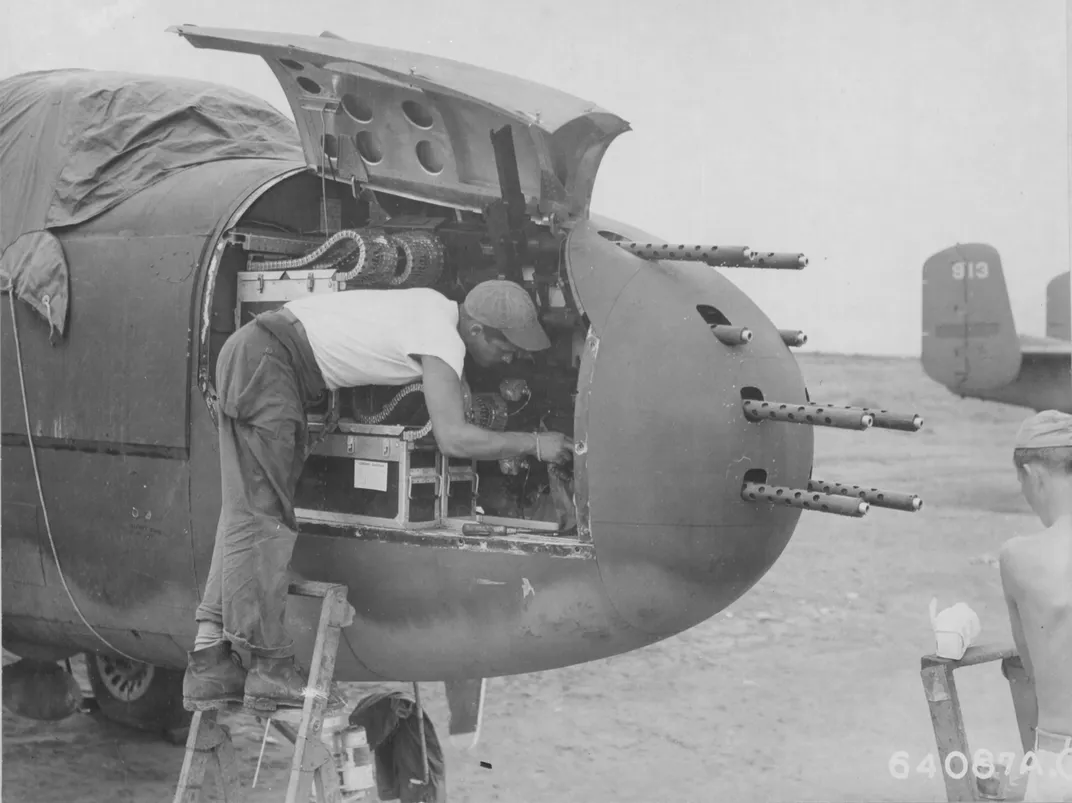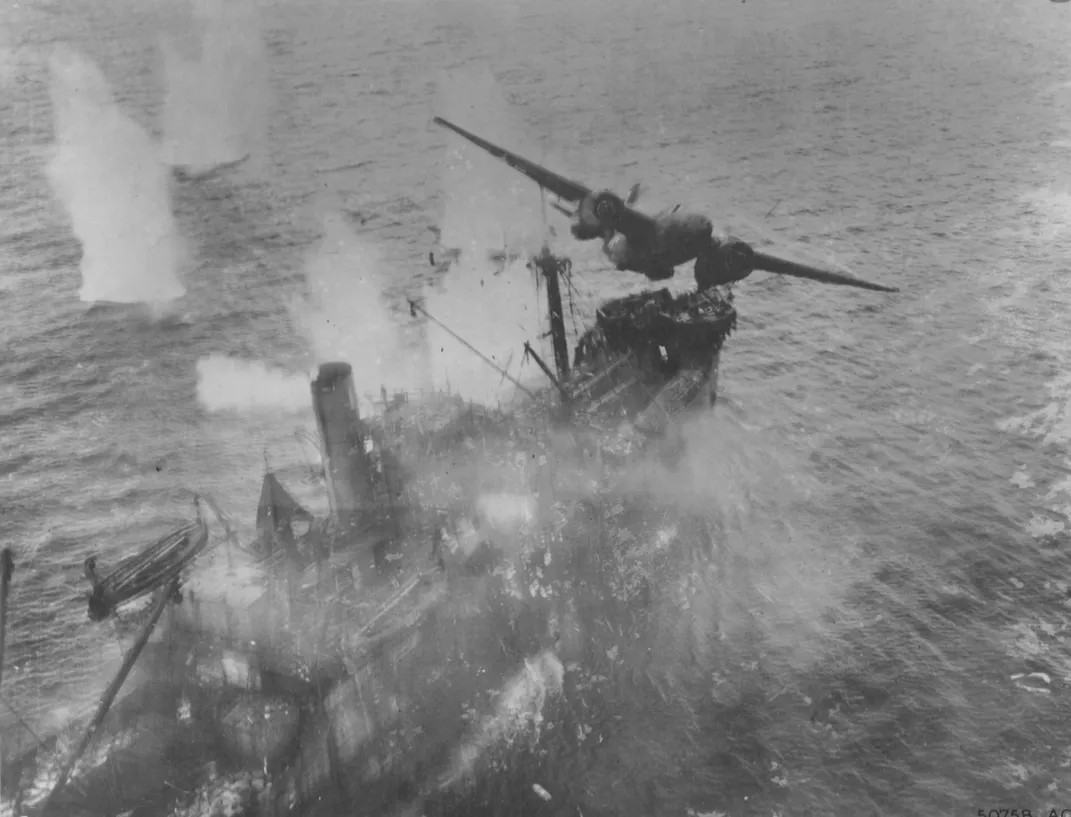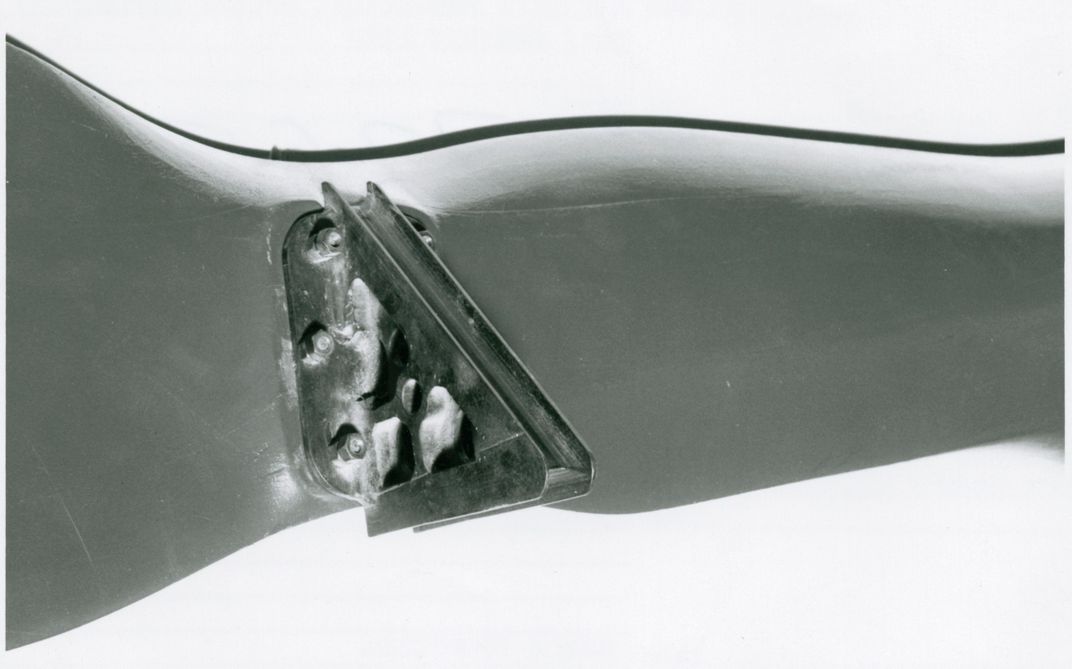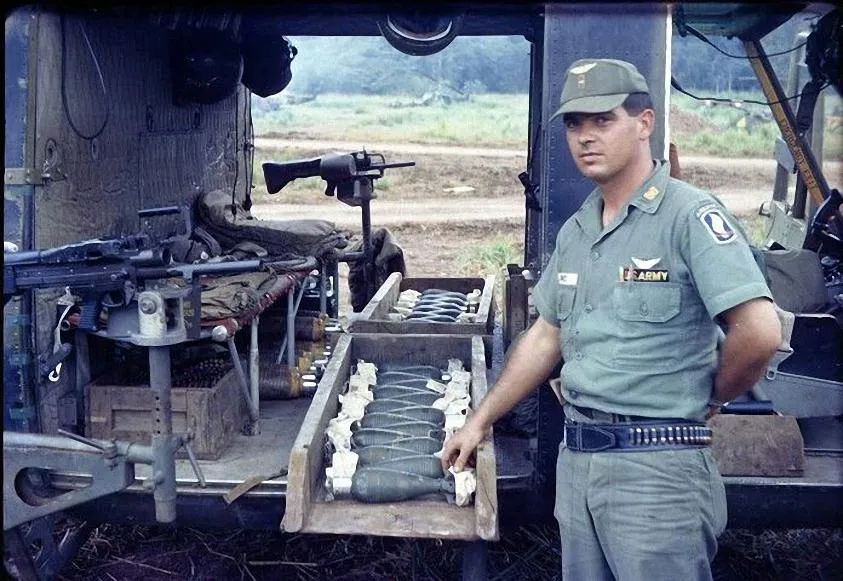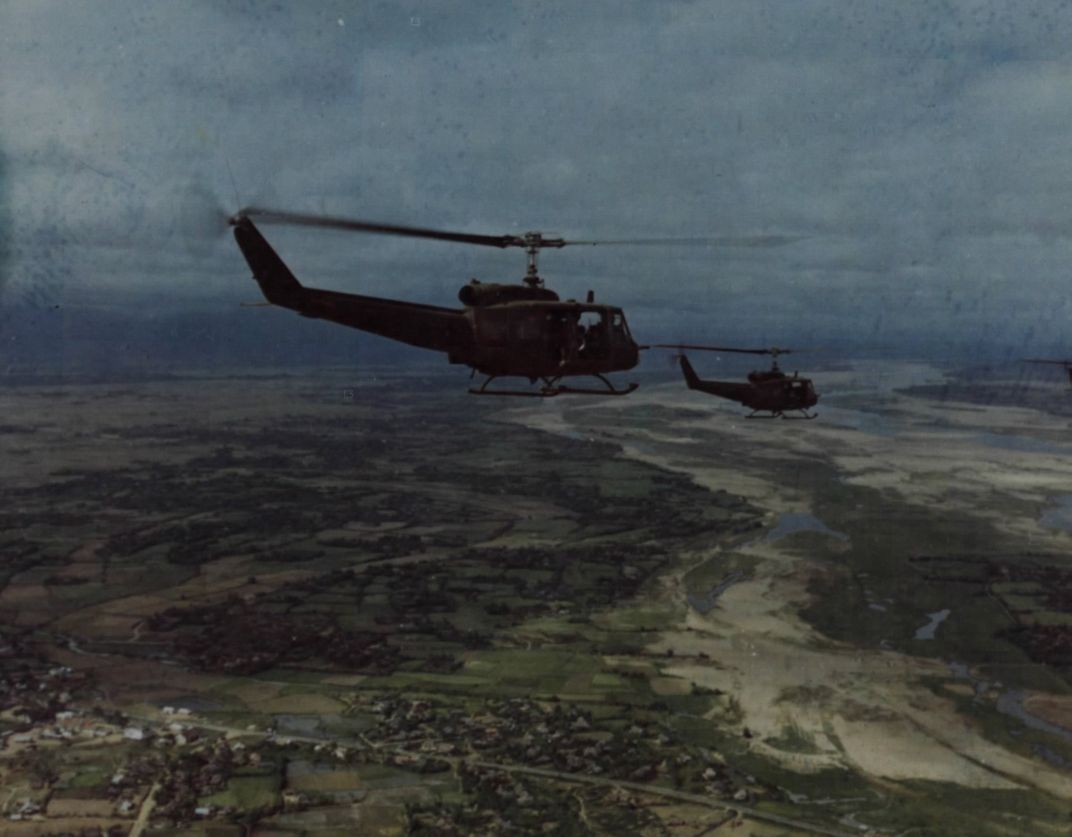Combat Is the Mother of Invention
Seven airplanes that got better in the field.
/https://tf-cmsv2-smithsonianmag-media.s3.amazonaws.com/filer/33/1e/331e14bf-690e-4e27-8ce7-fea1511f8a80/04l_jj2018_a10_1232416_live.jpg)
When a french Morane-Saulnier Model L slipped behind them, the Germans in the Albatros reconnaissance airplane likely sensed no threat. They were flying over northern France on April Fool’s Day, 1915, but the outmoded Model L carried only a pilot and no gunner. Besides, in an era when aircraft couldn’t shoot straight ahead, the Albatros pilot and observer no doubt thought that an enemy right behind was little worry. Odd, though, that an unarmed scout would tailgate like this, wasn’t it?
Moments later, the Albatros pilot was killed instantly by a 15-round burst from a fixed, forward-firing Hotchkiss machine gun mounted on the spindly Model L’s cockpit. Helpless in the seat behind the slumped pilot, the observer rode the spiraling biplane down to his death, perhaps wondering: How could this happen?
Warplanes are subject to revision as combat rewrites requirements. Thinking outside the blueprints, sometimes flouting formalities and factory-standard procedures, creative minds from World War I to Desert Storm have custom-tweaked flying machines to suit the demands of the moment.
One of the first airplanes in history altered for purposes of aerial combat, the straight-shooting Model L was modified by its pilot, Roland Garros, and his personal mechanic, Jules Hue.
Early military pilots endured the shortcomings of standard equipment: Air-to-air combat was an awkward hit-and-miss, with swivel-mounted machine guns (or hand-held rifles) limited to broadside and backward fusillades. Accurate aerial marksmanship demanded a stationary machine gun, mounted inline with the cockpit and firing straight through the propeller arc. Point airplane at target. Pull trigger.
Forward shooting, however, had a drawback: In the line of fire, wooden propellers splintered to smithereens. Raymond Saulnier, designer of the Model L, had tried and failed to refine a mechanism that enabled a forward-aimed gun to shoot cleanly between spinning blades. When Roland Garros visited the Morane-Saulnier factory in December 1914, Saulnier updated him on the status of forward-firing. Convinced it could prove decisive in combat, Garros took temporary leave from Escadrille 23 of the French Air Service. In a spare-parts hangar at an airfield near Dunkirk, Garros and mechanic Jules Hue began modifying the Model L.
Garros estimated that 7 to 10 percent of 8mm Hotchkiss machine gun bullets fired through a spinning propeller would strike a blade. Hue concentrated on fabricating wedge-shaped steel bullet deflectors to attach to each propeller blade. The novel design integrated a grooved channel to capture the bullet, then divert it harmlessly away from the propeller (without ricocheting into the pilot). Garros, meanwhile, performed necessary modifications to the prop, shaping it to a narrower profile to accommodate deflectors while adding metal bracing to absorb the impact of bullet strikes. When multiple clips of Hotchkiss 8mm ammo could be fired into the whirling propeller without damage, the modification was combat-ready.
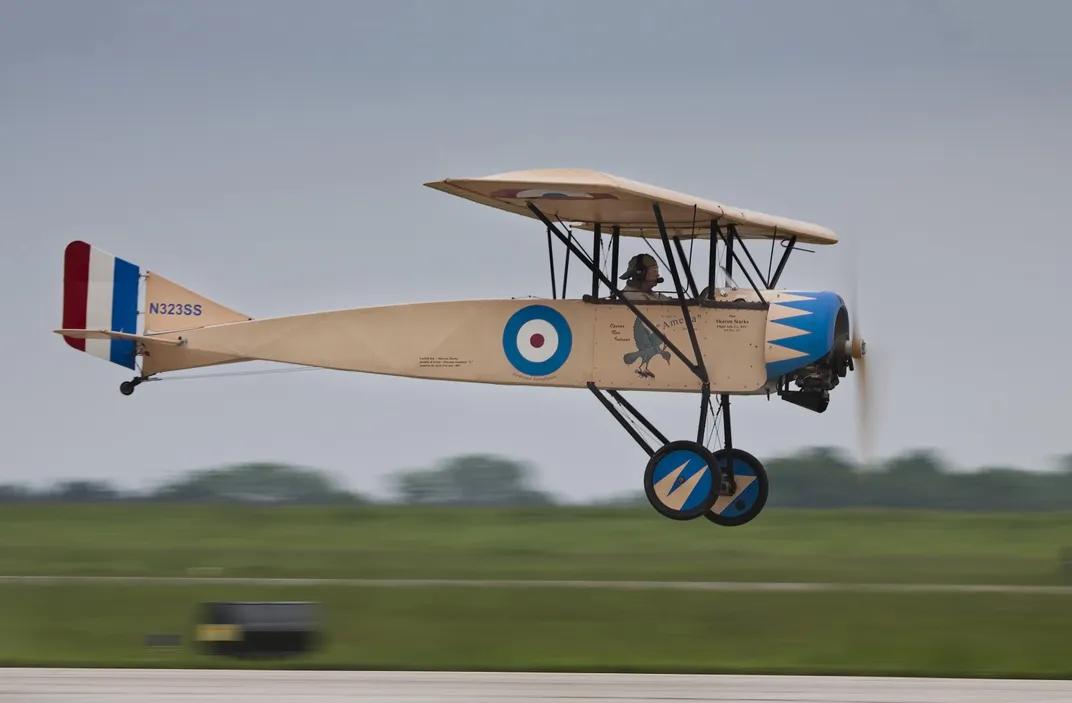
After dispatching the Albatros, Roland Garros downed two more enemy aircraft in 15 days, drawing lethal aim with the nose of the airplane and firing straight ahead. The streak won him a Legion of Honor citation.
Prop deflectors became old-school fast, though. Months later, Fokker Aircraft in Schwerin, Germany, developed an interruptor gear that reliably synchronized machine gun shots to travel between the spinning blades. Saulnier’s experiments began the evolution. Garros and Hue’s hangar modification proved the forward-firing concept in combat, and Fokker’s synchronizing mechanism perfected it. The era of the fighter plane began.
**********
Attacked by Japanese bombers just hours after Pearl Harbor and cut off from rescue and resupply, U.S. Marines of squadron VMF-211 on Wake Island were left with just four airworthy F4F-3 Wildcats to defend themselves. Lieutenant John F. Kinney was a Wildcat pilot and, before the war, a Pan American Airways airframe-and-engine mechanic. As squadron engineering officer, Kinney was tasked with keeping the surviving airplanes flying. In his book, Wake Island Pilot, he recalls psyching himself up for the challenge: “We had absolutely no repair manuals for the F4Fs and virtually no spare parts. But we were at war.”
One-hundred-pound bombs stored at Wake had been manufactured for Army Air Corps airplanes and didn’t fit Wildcat bomb racks. Solution: Racks designed for water-filled practice bombs were altered and installed on the aircraft. “This modification would allow us to use the army bombs—we hoped,” Kinney wrote. The standard hard tires used in Wildcat tailwheels—made for carrier decks, not soft coral-sand runways—were replaced with pneumatic tires.
When aircraft oxygen supplies ran out, a system was improvised to transfer oxygen from large welding tanks to smaller bottles installed in cockpits. The welding gas was pressurized at half the normal rate used for aviation, “[b]ut it was better than nothing, and it was absolutely essential for high-altitude flight,” Kinney wrote. A construction depot on the island contributed electrical wire for fashioning antenna loops installed in Wildcats to receive homing signals. “Marines are nothing if not willing to improvise,” Kinney observed.
Ingenuity alone couldn’t survive the ongoing onslaught by Japanese forces, however. On December 23, the Marine garrison on Wake Island surrendered. Not before Captain Henry Elrod sank the destroyer Kisaragi, however—with a 100-pound Army bomb, dropped from a field-modified Marine Corps Wildcat.
If there was a Maestro of Modifications in World War II, it would have to have been Major Paul “Pappy” Gunn, engineering and maintenance officer with the Army Air Forces 3rd Attack Group, based in Australia. A cinematic, volatile character, Gunn was twice the age of most crew members he flew with. Utterly lacking patience for red tape or chain of command courtesies, he spurned orders to go by the book. “Forget the book. Set fire to the goddamned book,” he once roared at a group commander.
Gunn believed high-altitude bomb runs exposed crews to unnecessary risk from Japanese anti-aircraft fire and fighters. When 16 new Douglas A-20A Havocs arrived in Australia lacking guns or bomb racks, Pappy saw opportunity. Snappy and responsive, the Havoc was more of a hybrid: half-fighter, half-bomber. It seemed ideal for low-level attacks—properly modified, of course. The local commander quoted chapter and verse prohibiting alteration of military assets, but Gunn eventually persuaded him to approve field modification of an unarmed A-20. The mod entailed substantial metal work, including removal of the bombardier’s station inside the Havoc’s glassed nose to install a quartet of .50-caliber machine guns. Another pair of forward-firing .50-calibers were added externally, one on each side of the fuselage.
General George Kenney, new commander of the 5th Air Force, showed up in Pappy’s hangar on an introductory inspection tour. In his book, The Saga of Pappy Gunn, Kenney describes his initial impression of the major: “It apparently hadn’t occurred to him to ask permission of anyone to install an armament load that was nothing like the original one, or to bother about what anyone else thought about cutting the airplane all apart to make new installations.”
But the general turned out to be more kindred spirit than hardliner. In the 1930s, he had helped develop para-frag bombs—23-pound fragmentary explosives dropped by parachute from low-flying aircraft. With Kenney’s blessing, Gunn modified the Havoc bomb bay to accommodate the tricky bombs, and designed a special honeycomb-shaped bomb rack to drop them.
Tests proved how devastating the low-level combo could be. Unleashing a barrage of forward fire, the Havoc’s six .50-calibers opened up a wide path of shredded jungle vegetation, neutralizing anyone and anything in the way. Para-frags drifting to the ground unleashed 360-degree death zones of flying shrapnel. Low-level attacks became the Havoc’s standard mission. Pappy’s mod later went mainstream when the A-20G variant rolled off the Douglas assembly line with his configuration factory-installed.
After the A-20 success, in the summer of 1942 Gunn shifted his attention to modifying a North American B-25 for low-flying skip-bombing. In this technique, as the bomber approaches the vessel broadside at high speed, it releases 250-pound bombs at an altitude no higher than 300 feet. Skipping across the ocean’s surface like a flat rock on a pond, the bombs impact the ship’s hull and detonate underwater.
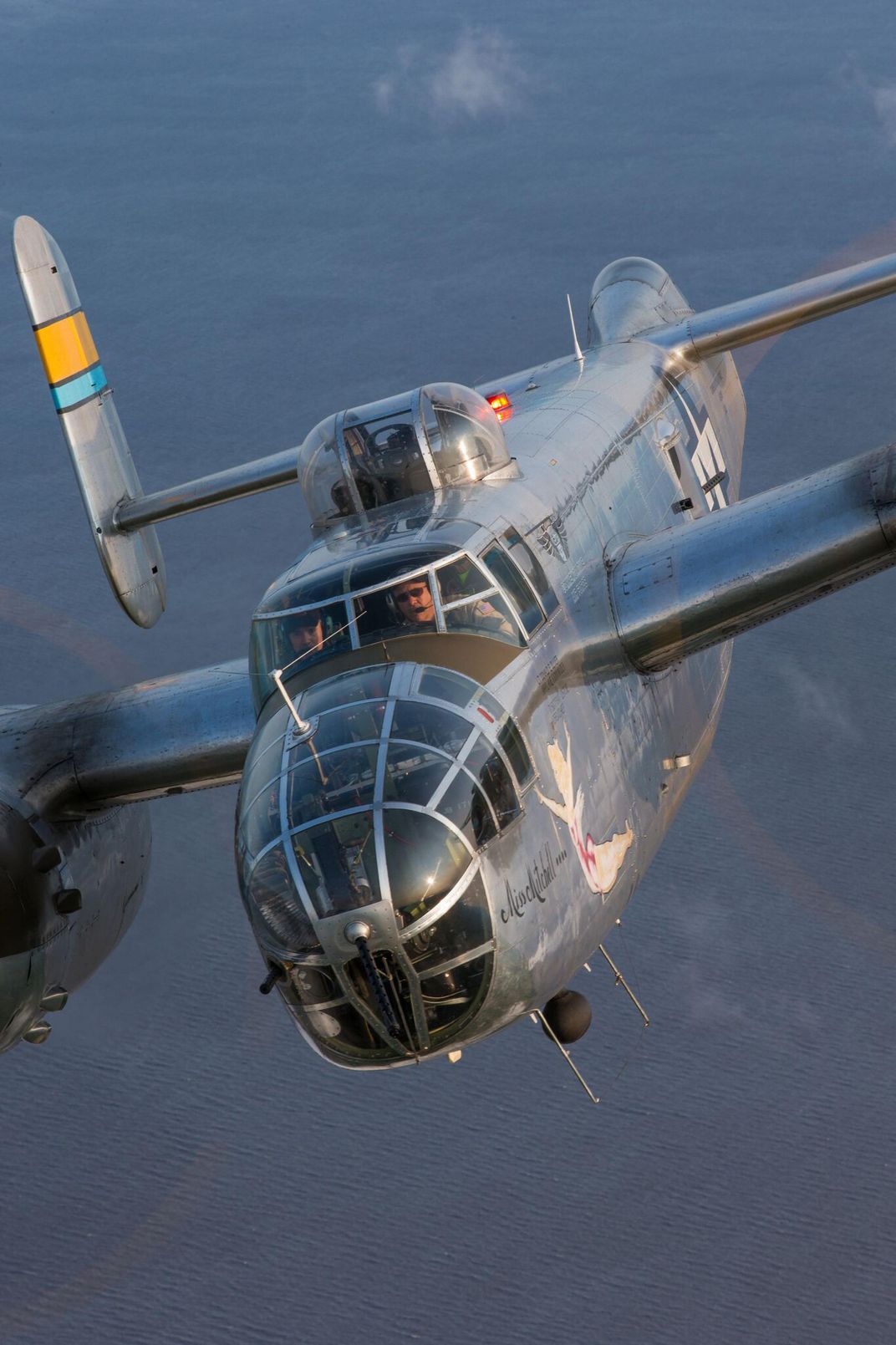
Intended for Japanese ships and dubbed the “commerce destroyer,” Gunn’s B-25 modification combined overwhelming strafing power to suppress ship anti-aircraft defenses with can’t-miss skip-bombing. Major teardown was necessary, including removal of the B-25’s gun turret and dismantling the bombardier’s compartment. Four .50-caliber machine guns were installed inside the nose and four more mounted in external blisters, two on each side of the fuselage below cockpit windows. Technical reps from North American Aviation arrived to observe, and the crowd in Gunn’s hangar grew.
In its first ground test, firing all .50-calibers at once caused rivets to pop out of the B-25’s over-stressed skin and the aluminum to deform in spots. Moreover, the bomber was so unbalanced it would barely fly. Kenney recalls bringing up the issue with Gunn. “The airplane looked to me as though it might be getting a little nose heavy. I asked Pappy how about the center of gravity. Pappy came right back with, “Oh, the C.G. Hell, General, we threw that away to save weight.”
After additional tweaks and test flights, the perfected modification was expanded to 12 B-25s. On March 1, 1943, before a multi-pronged attack on a Japanese convoy en route to a base on New Guinea, Pappy-modified B-25s strafed and skip-bombed the ships, sinking four cargo transports and two destroyers in 15 minutes.
A month later, Major Gunn received orders to report to the North American Aviation factory in Los Angeles to assist engineers and workers integrating his modifications into B-25s on the assembly line.
**********
Though the Army Air Forces and Navy employed rudimentary electronic countermeasures in World War II, it was the Marine Corps who established the first dedicated ECM squadron, VMC-1, during the Korean War. What Marines had in get-it-done initiative, however, they lacked in purpose-built aircraft to meet a mounting threat: North Korea possessed air defense radars and was assumed to have radar-guided artillery. During the Korean War, virtually no airplanes came from the factory ready to electronically deter or confuse those weapons.
“All they had was the AD-2Q Skyraider,” says retired Marine Corps Colonel Wayne Whitten, who would spend his entire career in ECM. Designed during World War II to accommodate a pilot and an ECM operator (ECMO), the AD-2’s first-gen equipment was “seriously outdated by 1951,” Whitten says. The electronic warfare boxes in Skyraiders included a radar receiver and signal analyzer capable of intercepting and classifying Russian or Chinese radar used by the North Koreans. However, Skyraiders lacked critical directional finding capability to plot the location of radar installations.
Two VMC-1 technicians, Joe Bouher and “Doc” Grimes, took on the task of modifying the AD-2s to meet the needs of combat pilots in Korea. The only off-the-shelf navigation aids available for Skyraiders were low-tech direction finders: a manually rotated antenna, plus a pencil and paper to jot down fixes. However, Bouher and Grimes located two APA-17 automatic direction finders. With a motorized antenna and a radar-like illuminated screen display, the system was originally designed for B-24 bombers. Substantial in-house retrofitting of the two-seat Skyraiders was required to accommodate the display. “I’m surprised they could even stuff an ECMO into an AD-2 after all that,” says Whitten. For a time, the field-modified AD-2Q was the sole ECM aircraft flying out of a base in Korea. Over the course of a year, the squadron located several air defense radars operating in North Korea.
VMC-1 subsequently received several AD-4NL Skyraiders, three-seaters configured for pilot, radio operator, and ECMO. The configuration did not fit the needs of the squadron, however. With a wartime upsurge in trainees, new Skyraiders needed modification to train ECMOs while actually performing ECM missions. What the aircraft needed was a seat for a pilot plus two fully equipped ECM seats. The radio operator was not critical. Technical Sergeant Dan Georgia, a pioneering ECM tech, got the call.
Georgia took one AD-4NL to a repair depot in Itami, Japan, with specialized tools. “He was basically a one-man show,” says Whitten. “Georgia was a guy who knew what he wanted and how to do it. He had free rein to get all the electronic boxes and components he needed to put in there.”
In Georgia’s modified configuration, the senior ECMO could execute ECM mission requirements while the trainee observing in the second seat also had access to most of the same equipment. Real-world, in-flight experience on actual missions streamlined ECM training and prepared new operators to meet surging demand. “There was no training base in the States or anywhere else where you could go to school like this,” says Whitten.
In recognition of his Skyraider modification, Georgia received a Bronze Star. “Needless to say, it was pretty unusual to give an avionics tech a Bronze Star,” Whitten notes. “Dan Georgia was in his prime during that work. You know Marines. He knew how to beg, borrow, and steal everything he needed.”
**********
“Yes, Casper Platoon UH-1 helicopters were used for aerial bombing missions using MADS and other improvised systems,” says Ned Costa, executive director of the Casper Aviation Platoon Organization, recounting the early days of the Mortar Aerial Delivery System.
“Leave a bunch of guys alone to their own devices and it’s amazing what they can come up with,” John Hoza, pilot of the MAD bomber, explains today. Low-altitude, low-speed bomb drops from a chopper could improve the precision of close air support and shorten response time in Vietnam. But how to get from standard equipment to “bombs away”? Factory armament on Bell UH-1 gunships was limited to machine guns and rocket pods. The only way to select the bomb option was field modification.
The exact provenance of MADS is uncertain, but apparently dates to 1965. The modification combined skilled VTOL (vertical-takeoff-and-landing) piloting with redneck engineering. Constructed locally at Bien Hoa Air Base, the MADS consisted of twin wooden bomb chutes installed inside the cargo compartment of a standard Huey.
“I don’t remember where they got lumber to build it,” Hoza says. “In those days, we relocated government assets wherever we could scrounge them. They may have used old ammo boxes that were cut up.” The wooden chutes allowed bombs to feed smoothly, and a sliding door at the bottom controlled release. The two chutes extended from opposing side doors of the cargo compartment and were manually operated by three crew members. One pulled a rope to raise the chutes into gravity-feed position, while the other two operated the sliding doors, releasing the desired number of rounds.
“We dropped 81mm mortars and 20-pound fragmentation bombs,” John Hoza recalls. “They both had spin fuses installed, which we managed to get from the Air Force. We experimented a lot and determined that 2,000 feet altitude and about 60 knots airspeed into the wind was perfect.” Spin fuses armed after 150 revolutions, and they achieved a detonation rate of approximately 98 percent. The modifiers also discovered that three feet of engineer’s tape tied to the fins of the rounds stabilized them so they would hit the ground with the fuse pointing down. Soaking the engineer’s tape in Huey hydraulic fluid added a little more drag.
Official descriptions of the makeshift MADS bombsight maintain military straight face. “Rounds are released when the aircraft’s foot pedal attaching bolt is aligned with the target,” one 1966 Army document reports soberly. And that’s really how it was. Hoza says, “We worked out a system. I could line up the target by the bolts on the tail rotor pedals. When the target reached the second bolt closest to the floorboard, I’d tell them to drop. It was amazingly accurate too.”
Most bomb runs were linear, Hoza says, “but if we were going for a bridge or a hooch or something like that, then we’d stop and come to a hover. You’d release a few and see where they hit, then adjust and drop a few more.” Enemy troops, unacquainted with the bombing helicopter concept, were often taken by surprise. While Huey gunships were easy to spot by the rocket pods hanging over the sides, the MAD bomber was indistinguishable from an unarmed supply helicopter. A 1966 operational report of the 145th Aviation Battalion, which supported the 173rd, declared it “[a] highly versatile weapon, which, when effectively employed, can deliver rapid, devastating, accurate ordnance.”
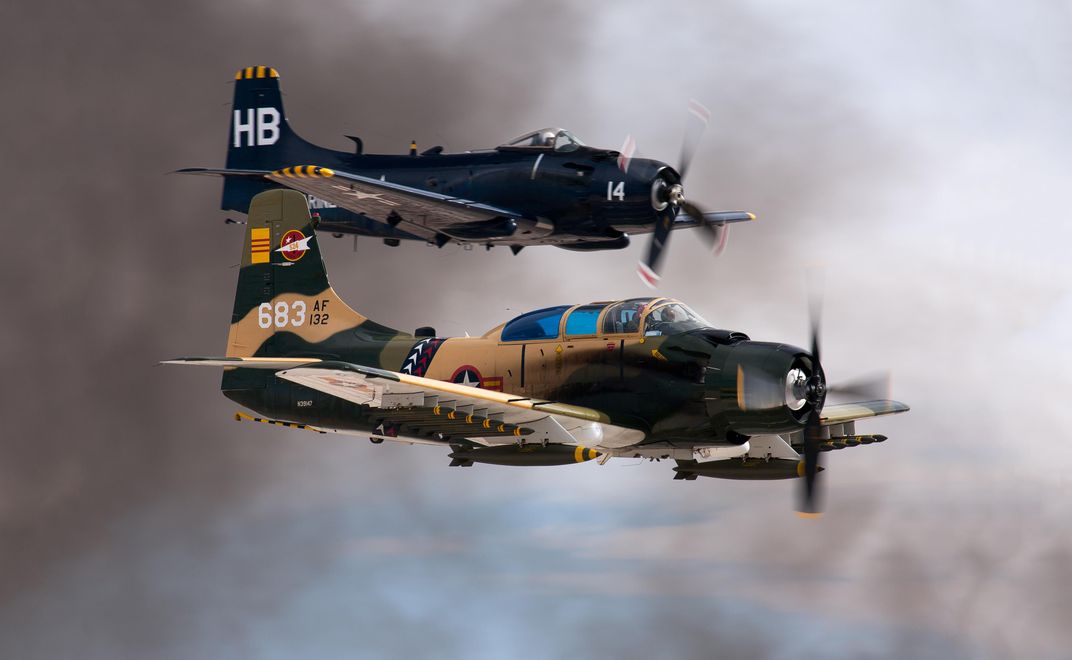
“In 1966, Ken Jones and I flew the majority of all MAD missions,” Hoza says. “I have no idea how many there were.” Use of the MAD bomber petered out in 1967.
**********
“As weapons and tactics officers, we always just took what was given to us and tried to use it to the best of our ability,” says Michael Isherwood, an A-10 Warthog pilot with the 23rd Fighter Wing during Operation Desert Storm.
Utilizing standard equipment in a not-so-standard capacity is another variation on warplane modification. Warthogs had all the prerequisites for effective close air support in daylight VFR (visual flight rules) conditions. Absent in Desert Storm, however, was after-dark technology pilots take for granted today. No night-vision goggles, no FLIR (Forward Looking Infrared cameras) targeting pod. Locating ground targets such as tanks, trucks, and missile launchers in darkness, not to mention telling bad guys from good, was difficult.
In the mid-1980s, Warthog armament was upgraded to include the AGM-65 Maverick guided missile. Designed for air-to-surface use, the D-model Maverick incorporates an infrared guidance sensor that generates an image on a cockpit monitor. Someone, sometime realized the Maverick’s camera could be repurposed to enable pilots to see in the dark.
Tilt of the IR camera inside the missile is controllable and allows substantial adjustment. A cockpit button could be pre-calibrated to tilt the Maverick camera downward, a certain number of degrees “nose low.” This brought a good-sized portion of real estate below into view on the cockpit monitor. Now, the Maverick missile became a poor-man’s ground-scanning FLIR, enabling a “Nighthog” pilot to detect and identify targets in the dark.
The camera toggled between wide-angle and narrow field of view. “Usually, you’d start in the wide field and once you began to recognize features on the ground around the target, you’d switch to narrow field of view to amplify the picture,” Isherwood says. “We always carried two IR missiles at night. You’d shoot one and hope you hit something and it started to burn.” After that first Maverick, the pilot utilized bombs and the A-10’s massive nose gun. The last thing to go was the Maverick used as the night-vision device, “then you’d head on back home.”
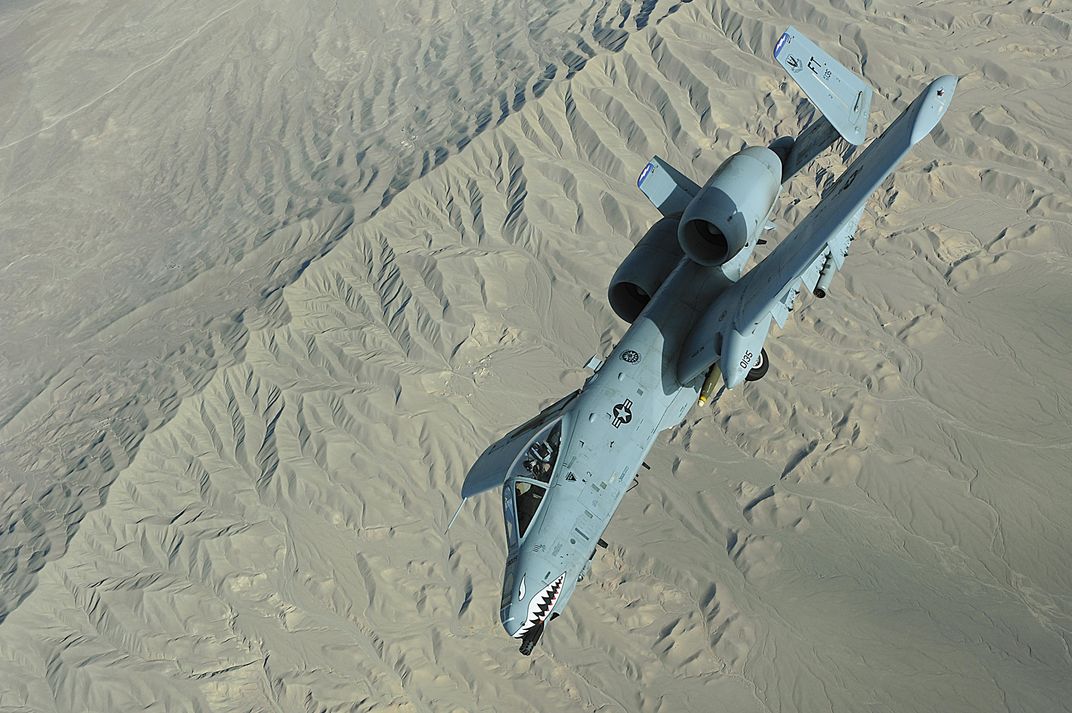
Another benefit: When assigned night targets by ground tactical control, Isherwood utilized the Maverick camera to view the target, then verified it by describing it back to the ground controller. “Five or six times, they realized they had given me the wrong target,” he says.
Today, night-vision goggles are standard equipment for A-10 pilots. As William Smallwood reported for Air & Space in the February/March 1999 issue, “when A-10 pilots fly as forward air controllers, they use their night-vision goggles in conjunction with an infrared laser on a pointer that the pilot attaches to his finger with Velcro. While patrolling for targets, often in communication with ground forces, an A-10 forward air controller can simply point his finger at a truck, tank, troop concentration, or artillery piece, and fellow NVG-wearing pilots will be able to see the laser dot on the target they are to attack.” The improvement is a direct progression from the improvisations that began in Desert Storm, when pilots used the imaging sensors on their Maverick missiles.
Whoever first utilized a standard Maverick in this non-standard way is not recorded. “It was very successful,” Isherwood says, “so everyone’s gonna claim they thought of it first.”
Today, advanced technology, the complex procurement process, and the cost of 21st century aircraft rule out maverick modifications that were acceptable just a few decades before, says Jennifer Spradlin of Air Combat Command Public Affairs. Free spirits like Pappy Gunn and other DIYers would now run afoul of Air Force Instruction 21-101, which stipulates “Modifications (temporary, permanent or safety) to AF aircraft or equipment are expressly prohibited without Project Manager approval.”
Seems almost un-American.
